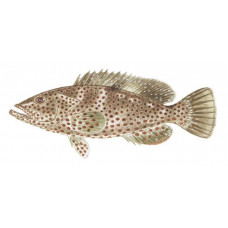Latin name
Epinephelus adscensionis
Other names
Grouper, jack, rock cod; French: mérou oualioua; Portuguese: garoupapintada; Spanish: mero cabrilla.
Identification
It has a coloration from tan to olive-brown, with many large reddish or dark spots covering the entire body and fins. It looks like a red hind individual, but has one to four distinctive pale or dark spots along the back that appear below the middle of the dorsal fin, behind the dorsal fin on the caudal fluke, and below the dorsal and soft parts of the dorsal fin. The caudal and anal fins have broad whitish outer edges, but lack the additional blackish edges found on the dorsal, caudal, and anal fins. It can turn sharply pale or darker.
Distribution
In the western Atlantic Ocean it occurs from Massachusetts to southeastern Brazil, including Bermuda, the Bahamas, the eastern Caribbean, and the northern Gulf of Mexico. North of Florida, it is rare.
Habitat
Solitary fish, lives in rocky or rough coastal areas in shallow water, sometimes entering deep reefs. They can often be found drifting off the bottom.
Size
Can reach up to 2 feet in length. The world record holder for fishing on all tackle is a 9-pound fish.
Life history and Behavior
No information
Food and feeding habits
They usually feed on crabs and fish, as well as young triggerfish and sea turtles.
Reproduction
No information
| Classification | |
| Phylum | Chordata |
| Class | Actinopterygii |
| Squad | Carangiformes |
| Family | Carangidae |
| Genus | Seriola |
| Species | S. rivoliana |
| Features | |
| Conservation status | Least Concern |
| Habitat | Pelagic |
| Life span, years | 12 |
| Maximum body weight, kg | 59.9 |
| Maximum length, cm | 160 |
| Sailing speed, m/s | No information |
| Threat to people | Edible |
| Way of eating | Predator |



